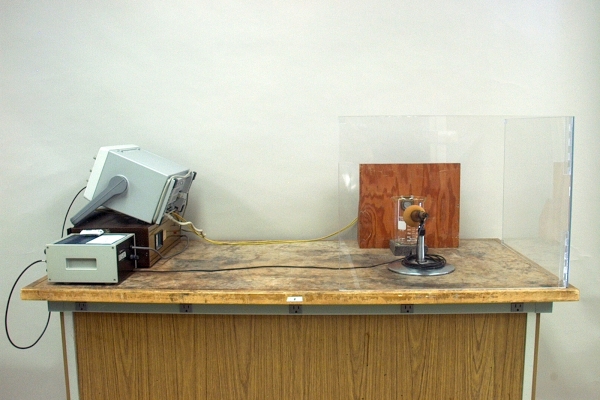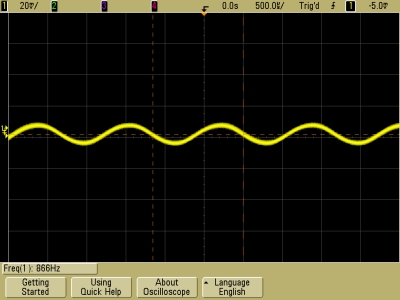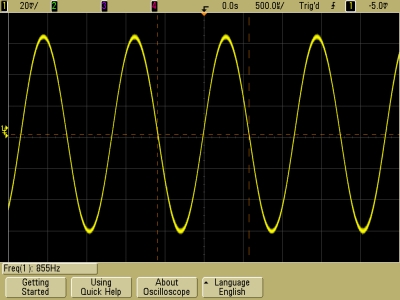
A video of this demonstration is available at this link.
A function generator, set to produce a sine wave, is connected to the input of a power amplifier, which sends the amplified sine wave to a loudspeaker driver. Just in front of the loudspeaker driver is a 1000-ml beaker, which sits on two chalkboard erasers for accoustical isolation. A microphone placed near the beaker, opposite the loudspeaker driver, picks up the vibrations of the beaker. The resulting signal goes to the oscilloscope, whose display you can project for the class to see. Tap the beaker, and it rings at its natural frequency. Turn on the amplifier and function generator (in that order!). The sound from the loudspeaker driver sets the beaker vibrating, and you see a sinusoidal trace on the oscilloscope. Slowly change the frequency of the function generator toward the natural frequency of the beaker. (This is usually somewhere between about 800 and 900 Hz. If you remember the pitch of the sound the beaker made when you tapped it, you can hear whether the frequency of the sine wave is lower or higher than this). When the frequency of the sine wave matches that of the beaker, the oscilloscope trace increases greatly in amplitude. At this point, you can take a set of keys and dangle them against the rim of the beaker. The class will be able to hear that the keys rattle, which illustrates the rather large motion along the rim of the beaker. Make sure that the oscilloscope trace is stable at its maximum. If it is not, make a slight adjustment to the frequency until it stays at maximum. Now turn the volume control on the input of the power amplifier quickly up until the beaker shatters, and then immediately turn it back down. If you keep the volume too high for any significant time, you will burn out the loudspeaker driver.
As noted above, if you rest the beaker on your hand (or on a firm cushion) and then tap it, it rings. The frequency, or pitch, of the sound that it produces is a function of its density, its dimensions and the Young’s modulus of the material of which it is made, in this case, glass. For a piece of material under compression, the Young’s modulus is the ratio of the applied pressure (force per cross-sectional area) to its corresponding change in length, or the stress divided by the strain. It is a measure of the material’s elasticity, which is why it is sometimes called the modulus of elasticity. The greater the density of the beaker or the larger its dimensions, the lower its pitch, and the larger the Young’s modulus, the higher its pitch. This pitch is the frequency of the fundamental mode of vibration of the beaker, its natural frequency. You can find examples of this for vibrating bars in demonstration 40.24 -- Idiophones, and material about vibrating wine glasses (which are similar to beakers) in In Vino Veritas: A study of wineglass acoustics (A.P. French, American Journal of Physics 51 688 (1983)) and Wine glasses, bell modes, and Lord Rayleigh (Thomas D. Rossing, The Physics Teacher 28 582 (1990)).
We can set the beaker oscillating at any desired frequency by providing some kind of periodic excitation. One way to do this is to produce a sine wave, play it through a loudspeaker, and place the beaker near it. The pressure fluctuations in the sound wave cause the beaker to vibrate at the frequency of the sine wave. If this frequency does not match the natural frequency of the beaker, however, the amplitude of its vibration remains small. When the frequency of the sine wave is close to the natural frequency of the beaker, the amplitude of vibration becomes larger. When the frequency of the sine wave matches, or is resonant with, the natural frequency of the beaker – its resonant frequency – the amplitude of the vibration of the beaker becomes very great. When you are operating this demonstration, you (and the class) see this as an increase in the amplitude of the oscilloscope trace, as shown below:
Off resonance At resonance Typically, the natural frequency of the beaker is between about 800 Hz and about 900 Hz, or just above the G that sits atop the G-clef staff (784 Hz), to just above the A on the first ledger line (880 Hz). For the beaker whose vibration is shown in the traces above, the resonant frequency is 855, Hz, a quarter-tone below the A on the first ledger line.
Note the large difference in the amplitude of the vibration of the beaker, between when the frequency of the sine wave is 11 Hz above the resonant frequency, and when it matches the resonant frequency. For the trace at right, the amplitude of the vibration of the beaker is large enough that at the antinodes, there is considerable displacement of the rim of the beaker from its equilibrium position. Because of this, if you dangle a set of keys against the rim, they rattle against it, which the class can hear. If you now quickly increase the volume of the sine wave, the amplitude of the vibration of the beaker becomes so great that the displacement at the antinodes exceeds its elastic limit, and the beaker shatters. The resonance peak is quite narrow. (Q, the quality, which is ω0/Δω, where Δω is the full width of the peak at half maximum, is high.) So if the frequency of the function generator differs only slightly from the resonant frequency of the beaker, the amplitude of its vibration can decrease noticeably – sometimes enough to make it difficult to break the beaker. When you find the resonant frequency, if you take some time to make sure that the oscilloscope trace stays at its maximum, you can have confidence that you will be able easily to break the beaker.
Important note: Though the loudspeaker driver is capable of dissipating a fair amount of power, it is still possible to burn it out if you keep the volume up too high for too long. Therefore, when you perform this demonstration, when you find the resonant frequency, make sure the function generator stays there, and when you wish to shatter the beaker, turn the volume quickly up, and as soon as the beaker breaks, immediately turn it back down. If, when you turn the volume up, the beaker does not shatter, immediately turn it back down and recheck that the beaker is at resonance. Then try again.
It may be tempting to try to break the beaker by keeping the volume up, then slowly tuning the function generator until you reach the resonant frequency. There are two reasons not to do this. First, even at resonance, the requisite power to break the beaker is great enough that the sound volume would be obnoxiously loud. Second, if you keep the power this high for any significant time, you will almost certainly burn out the loudspeaker driver. Therefore, always tune the function generator as described above to find resonance, then as quickly as possible, break the beaker by turning the volume up, and immediately down.

